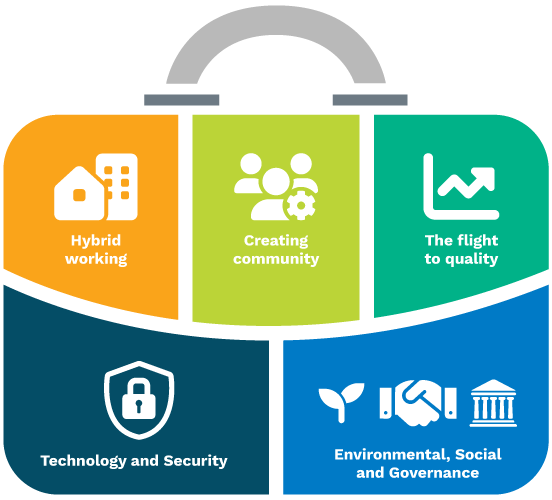Reimagining the future of office space: new expectations for the post-pandemic workplace
The COVID-19 pandemic has thrown up many challenges. Businesses around the world had to move quickly to protect employees by implementing new ways of working. With office doors forced to close, flexible working arrangements moved from concept to reality as employees headed home to work. However, as office doors begin to open again, what does the future hold for the working environment? This is the question that was explored at the Future of Office Space Summit on 23 March 2022.
Atlassian, Google, Lendlease, CBRE, Investa, Charter Hall and more. The Future of Office Space Summit brought together the brightest minds in the industry to share their vision for the future of our working environment.

Hybrid working
For many, it didn’t take long for the excitement of working from home to wear off. Feelings of isolation set in and distractions multiplied. While many businesses initially contemplated letting square meterage go as the working-from-home phenomenon took hold, it very soon became apparent that maintaining office space was far from a thing of the past.
“The pandemic certainly accelerated what was already a trend and remote working became our norm,” Rob Kearsley, Director of APAC Product Management at MRI Software, said.
“There’s no doubt that many employees like the flexibility of working from home – and, according to data presented at the Future of Office Space Summit, approximately half of employees believe they are more productive when working from a home environment. However, further data presented at the Summit suggests that workers are, in fact, more productive in the office.
“Couple this with the fact that surveys show that an equal number of employees would prefer to go to the office for at least one day a week, and it’s clear that having office space is certainly not a thing of the past. Businesses need to look to more flexible working models that incentivise employees to leave home and head into the office.”
At the Summit, Sabine Lam, Google’s Global Lead for Real Estate and Workplace Digital Building Platform and Governance, noted that her company has implemented a 3/2 hybrid working model – effectively mandating time back in the office.
“Right now, no one can really predict what ‘hybrid working’ will look like going forward, as it will differ for each business,” Rob said, pointing to the Google model. “However, the consensus from the presenters at the Summit is that each business will need to analyse the performance criteria for each of their employees and, in turn, work out how to create community by incorporating elements of collaboration, contemplation, concentration and connection.”
Creating community
A common theme across the presentations at the Future of Office Space Summit was the need to move from ‘cookie-cutter’ office environments to settings that create a sense of community.
“Building this sense of community will require tenants to work more closely with agents and landlords to develop functional spaces and create an overall experience,” Jonathan Kaars, Account Executive at MRI Software, said. “For example, having a mobile platform connected to the property to enable security, allowing access to shared spaces, and providing amenities like gyms, end-of-journey facilities, and food and beverage services.
“These all contribute to a pleasant and frictionless experience to encourage staff to want to attend the office and enjoy everything the workspace has to offer.”
Jonathan said that presenter Adam Gardner, Head of Products at Next DC, noted that ‘work-life balance’ is a thing of the past.
“Instead, Adam explained that ‘work-life integration’ is the way forward,” he said. “It’s all about creating an environment that pulls your team into the office, rather than having to push them to attend.
“In essence, businesses have to earn their employees’ commute.”
The flight to quality
As a result of the need to ‘earn the commute’, businesses are seeking out new and better office spaces.
“Employee costs for a business can be in the area of 10 times the cost of office space, so many businesses are prepared to pay more for premium spaces to attract and retain their team,” Burcu Salman, Account Manager at MRI Software, said.
In this context, Burcu said that more than one presenter at the Future of Office Space Summit pointed to the fact that the Sydney CBD needs to become a CED – a ‘Central Experience District’.
“There needs to be more diversity of attractions, poorer properties need to be upgraded and transport infrastructure needs to be improved,” she said. “This will entice employees back to the CBD, so they will not only enjoy a better working environment, but also better surrounding places.”
Burcu noted that a common theme across almost every presentation was the need for businesses to be environmentally conscious.
“There are huge opportunities for developers to refurbish existing office stock with environmentally-friendly options in mind,” she said.
Accessibility via technology
Whatever the type of office space, having good technology in place is a must.
“We’ve all become much more aware of technology in the last few years,” Jonathan Kaars said. “It permeates every part of our lives – both on a personal and a work level – and more and more, it will impact the way businesses and employees interact with office spaces.”
But there was a note of caution.
“Yes, to be more environmentally and employee friendly, office spaces need to focus on digital security,” Jonathan said. “Things like sensors to monitor temperature and the energy efficient operation of facilities will result in gains but will also enable a massive amount of data to be gathered, which may include personal details. This means data privacy and anonymisation will need to be front and centre.”
Environmental social governance
All in all, the key message at the Future of Office Space Summit was one of environmental social governance – or ESG.
“ESG is about businesses setting standards for their operations,” Rob Kearsley said. “Environmental criteria consider how the business performs as a steward of nature. Social criteria examine how the business manages relationships with employees, customers and the community. And governance deals with the business’s leadership and administration.
“Moving forward, ESG will inform the investment decisions of more and more businesses as they make decisions about their office space.”
To learn more about how technology can help you improve workplace operations, book a free demo below.
Unlocking efficiency: Leveraging managed services for streamlined property management
Explore the transformative power of Managed Services in the property management sector. In this webinar, we’ll share: Enhancing operational efficiency Leveraging expertise for streamlined data management Maximising scalability and flexibility …


